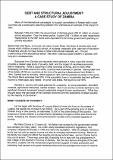May 1997 Debt and Structural Adjustment: A Case Study of Zambia

View/
Date
1997-05-30Author
Jesuit Centre for Theological Reflection
Type
Case StudyLanguage
enItem Usage Stats
52
views
views
64
downloads
downloads
Abstract
Many of the international campaigns to support cancellation of foreign debt in poor countries use a particularly disturbing statistic from Zambia as an example of the impact of debt: Between 1990 and 1993, the government of Zambia spent US$ 37 million on primary school education. Over the same period, it spent US$ 1.3 billion on debt repayments. Repayments to the IMF alone were equivalent to ten times government spending on primary education. Behind that cold figure, of course, are many human faces, the faces of parents who must choose which children to send to school, of students, especially girls, deprived of education, of teachers who do not have books or other instructional materials, etc Chronic under funding of the educational sector has been a serious social problem in Zambia, with long-term consequences.
Description
Zambia is country with great potential for prosperity: a young population, abundant minerals, agricultural resources, central location. But it is a country currently stymied in any significant forward movement toward sustainable integral human development. What has brought about the sad state of the Zambian economy and the experience of abject poverty by the majority of Zambians.